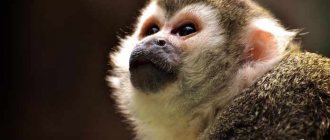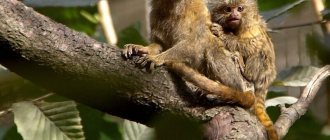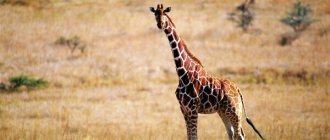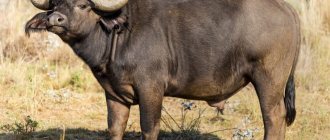The intelligence quotient of the smartest monkey is equal to the human norm - from 75 to 95. What have you achieved? Talk, joke, solve math problems, understand words, lie, be sad, swear, love, fry fish? Monkeys can do this too.
By the way, December 14 is Monkey Day. The holiday is unofficial for now, but quite international. It started as a student joke in 2000 and is now celebrated around the world by zoos, animal societies and just anyone in the know.
Current
- Ski resort video goes viral after skier falls
- Zoo's first alpha female in 70 years risks losing throne
- A luxury house in Sicily can be rented for €1
Yours my understand
For example, rhesus monkeys. Scientists have found that they are able to solve examples. True, they are very simple - like 1 + 1. But the smartest ones are, of course, apes. First of all, gorillas and chimpanzees (our closest animal relatives). And not just smart. And smart people and smart girls. Prodigies of the monkey world.
They are capable of not only understanding human speech (with appropriate training, of course), but also “speaking” themselves. In quotes - because monkeys cannot speak like us: their tongue is not so flexible. In the literal sense of the word. The speech apparatus of our relatives is structured differently. And although the press periodically flashes reports about talking monkeys (they can really imitate human speech), they will not utter full words. Although everyone understands perfectly well. But they can reproduce speech using deaf-mute gestures or using lexigrams (a specially developed sign system of words). The average chimpanzee can remember about 500 words. Geniuses (and there are some among monkeys) - up to 2000.
common chimpanzee
Chimpanzee social life
Chimpanzees usually live in groups, with an average of 15-20 individuals. The group, which is headed by one male leader, also includes females and males of all ages. Groups of chimpanzees occupy territories, which the males themselves protect from incursions by neighbors.
In places where there is enough food for a group to live comfortably, chimpanzees lead a sedentary lifestyle . However, if there is not enough food for the entire group, then they wander over fairly long distances in search of food. It happens that the territories of residence of several groups overlap. In this case, they unite for some time. It is interesting that in all conflicts the advantage goes to the group that contains more males and which, therefore, turns out to be stronger. Chimpanzees do not create permanent families . This means that any adult male has the right to freely choose his next girlfriend from among the adult females, both from his own group and from the group that has joined.
After an 8-month gestation period, a female chimpanzee gives birth to one absolutely helpless baby. Up to a year of life, the female carries the baby on her stomach, after which the baby independently transfers to her back. For as long as 9-9.5 years, the female and the cub are practically inseparable. His mother teaches him everything she knows, shows him the world around him and other members of the group. There are cases when teenagers are sent to their own “kindergarten”. there they frolic with peers under the supervision of several adults, usually females. When the baby turns 13 years old, the chimpanzee enters adulthood and begins to be considered independent members of the pack. At the same time, young males begin to fight for leadership,
Chimpanzees are quite aggressive animals . Conflicts often occur in the group, which even escalate into bloody fights, which often end in death. Apes are able to establish relationships with each other through a wide range of facial expressions, gestures and sounds with which they convey their approval. These animals express friendly feelings through picking each other's fur.
Chimpanzees get their food in the trees and on the ground, feeling in their place in both places. Their food includes:
- plant food,
- insects,
- small living creatures.
In addition, hungry chimpanzees as a whole group can go out hunting and capture, for example, a gazelle for shared food.
Skillful hands and a smart head
Chimpanzees are extremely smart ; they are able to use tools, deliberately selecting the most convenient tool. They are even capable of improving it. For example, to climb into an anthill, an ape uses a twig: it selects a twig of appropriate size and optimizes it by tearing off the leaves on it. Or, for example, they use a stick to knock down a tall growing fruit. Or to hit an opponent with it during a fight.
To break a nut, the monkey places it on a flat stone specially selected for this purpose, and uses another sharp stone to break the shell.
To quench their thirst, the chimpanzee uses a large leaf and uses it as a scoop. Or he makes a sponge from a pre-chewed leaf, dips it in a stream and squeezes the water into his mouth.
When hunting, great apes can stone a victim to death; a hail of cobblestones will await a predator, for example, a leopard, who dares to hunt these animals.
In order not to get wet when crossing a pond, chimpanzees are able to build a bridge from sticks, and they will use wide leaves as an umbrella, fly swatter, fan and as toilet paper.
“You are a dirty, bad toilet!”
Photo: AFP/EAST NEWS
This is what a gorilla named Coco once said, a research subject for scientists at Stanford University (USA), a popular favorite and a YouTube star. The reason for Coco's anger was her partner, a gorilla named Michael, who tore off the leg of her favorite rag doll. Coco uttered a four-word insult against Michael in deaf-mute language. Typically, gorillas and chimpanzees operate with very simple sentences consisting of one or two words: “Give me” or “Give me a banana.” Or “Give me a green banana” (if, for example, he wants a cucumber - by the way, this means that monkeys are able to compare and reason logically). But Coco is a genius. She was a genius. Unfortunately, she died in 2022, having lived for 46 years, which is quite a long time.
She also loved humor. She once called herself a “good bird,” saying that she could fly. Then, however, she “said” that she was joking. Flat? But above the waist.
Coco could think abstractly. She knew what “boredom” and “imagination” were. Once seeing a horse with a bit in its mouth, she declared: “The horse is sad,” pointing to its teeth. When Coco felt bad, she could express the strength of that “badness” on a scale. And when they showed her a photograph of a monkey being taken to the bath, she said: “I’m crying there.” Coco didn't like to bathe. Like many children. Despite her advanced age, she could be called a child of three to five years old. On average, monkeys reach the development level of a two to three year old human child.
Orangutans
Orangutan: features of life
"Orangutan" is translated from Malay as "man of the forest." This name refers to large apes that live in the jungles of the islands of Sumatra and Kalimantan. Orangutans are one of the most amazing creatures on earth. They differ in many ways from other apes.
Orangutans lead an arboreal lifestyle . Even though their weight is quite significant, 65-100 kg, they climb trees remarkably well even at a height of 15-20 m. They prefer not to go down to the ground.
Of course, due to the weight of their body, they cannot jump from branch to branch, but at the same time they are able to confidently and quickly climb trees.
Orangutans eat almost around the clock, eating
- fruit,
- foliage,
- bird eggs,
- chicks.
In the evenings, orangutans build their own homes , each with their own, where they settle down for the night. They sleep holding a branch with one of their paws so as not to fall down in their sleep.
Every night, orangutans settle down in a new place, for which they again build a “bed” for themselves. These animals practically do not form groups , preferring a solitary life or life in pairs (mother - cubs, female - male), although there are cases when a pair of adults and several cubs of different ages form almost a family.
The female of these animals gives birth to 1 cub. His mother takes care of him for about 7 years, until he is old enough to live independently.
Until the age of 3, a baby orangutan feeds only on its mother’s milk, and only after this period does the mother begin to give it solid food. She chews the leaves for him, thus making a vegetable puree for him.
She prepares the baby for adult life, teaching him to climb trees correctly and build a place to sleep. Baby orangutans are very playful and affectionate, and they perceive the entire process of education and training as an entertaining game.
Orangutans are very savvy animals. In captivity, they learn to use tools and are even able to make them themselves. But in conditions of free life, these apes rarely use their abilities: the incessant search for food does not give them time to develop their natural intelligence.
Einstein, Pushkin and Kanzi bonobos
Photo: Courtesy Everett Collection/EAST NEWS
This is the name of another monkey genius - the pygmy chimpanzee (bonobo). Kanzi communicates using lexigrams, and after watching a video of Koko the gorilla, he picked up some American Sign Language. Like many smart monkeys, he tries to reproduce our articulation in order to speak in a literal human voice. Alas, he is hampered by the monkey structure of the larynx and ligaments. He's not a parrot. That's why Kanzi won't speak.
But his descendants, if they are trained, are very capable. After millions of years. Speech, according to scientists, is generally the only thing that distinguishes us from them - in everything else we are more similar than is commonly thought.
Monkey diet
Monkeys are four-armed mammals whose diet is based on plant foods. As a rule, monkeys feed on fruits, leaves, flowers, and roots of various plants. Some species of monkeys easily eat small invertebrate animals and insects to diversify their diet. Some species eat special food, which is associated with the unique process of animal evolution.
Thus, marmosets happily feed on gum, which they find in places where tree trunks or branches are damaged. Monkeys easily get to the sweet plant juice by gnawing holes in the bark of trees, after which they lick this juice with their tongue. Red-backed sakis love to feast on hard fruit seeds. In order to split them, monkeys use a special interdental gap, which functions like ordinary tweezers.
Howler monkeys and howler monkeys have adapted to eating fairly hard and non-nutritious tree foliage. The stomach of such monkeys consists of several parts separated by partitions, which resembles the digestive system of ruminants.
Interesting fact! During evolution, some species of monkeys have developed so-called cheek pouches designed to store large amounts of food.
Thanks to this structure of the digestive tract, food travels a much longer path, so tough foliage is digested more efficiently. As a rule, such stomachs of leaf-eating monkeys contain all the necessary bacteria and microorganisms that help actively break down cellulose.
You can teach a hare to smoke
S. N. Denisov works with Rosa and Rafael in Koltushi (St. Petersburg ARAN)
And the monkey - to cook, wash, clean, wash dishes, eat with a fork and spoon, sleep on the bed. What else? Yes, almost everything we can do. And they love the same. For example, they prefer cooked food raw. At a nursery in the Congo, scientists gave chimpanzees slices of raw and boiled potatoes. Almost everyone chose boiled. And the raw one... was cooked. When they were given special devices to do this without fire, and they were shown the technology of the process.
All this can be done, perhaps, by any gorillas and chimpanzees. Not only Einsteins from the monkey world. Take, for example, the famous Rosa and Raphael, chimpanzees studied in the middle of the last century at the Koltush Anthropoid Research Center, near St. Petersburg. These two became a real family. Rosa, no worse than a real housewife, opened the cupboard with a key (the last one, however, she stole from the watchman’s pocket) and got to all sorts of goodies, Raphael built pyramids from cubes to get to the fruits lying on the top shelf. This couple dined using cutlery and slept on ordinary human beds. True, sometimes the monkeys put their legs, not their heads, on the pillow. And, throwing down the fork, they began to grab the food with their hands. Out of habit.
And these two monkeys loved each other. Just like their successors, the chimpanzees Gina and Charlie (modern inhabitants of the anthropoid land). When Charlie died, Gina was given a rubber Cheburashka. The monkey did not part with him for a year. She dragged it in her groin and armpits. And I was sad for a long time.
Gorilla
Good giants or monsters?
It is not difficult to imagine the feelings of the person who first saw a gorilla in front of him - a humanoid giant, frightening aliens with menacing screams, beating himself in the chest with his fists, breaking and uprooting young trees. Such encounters with forest monsters gave rise to terrible stories and tales about the fiends of hell, whose superhuman strength poses a mortal danger, if not for the human race, then for its psyche.
Unfortunately, this is not an exaggeration. Such legends, which pushed the public to the fact that these humanoid creatures began to be treated too incorrectly, at one time caused an almost uncontrolled, panicky extermination of gorillas. The species was threatened with complete extinction if it were not for the work and efforts of scientists who took under their protection these giants, about whom in those years people knew almost nothing at all.
As it turned out, it seemed that these terrible monsters are the most peaceful herbivores that feed only on plant foods. In addition they are almost completely non-aggressive , and demonstrate their strength and, moreover, use it only when there is a real danger and if someone comes to their territory.
Moreover, in order to avoid needless bloodshed, gorillas try to scare off offenders , no matter whether it is another male, a ruler of another species, or a human. Then all possible means of intimidation come into play:
- roar,
- screams,
- pounding your chest with your fists,
- breaking down trees, etc.
Features of the life of a gorilla
Gorillas, like chimpanzees, live in small groups, but their numbers are usually smaller - 5-10 individuals. Among them there is usually the head of the group - the eldest male, several females with cubs of different ages and 1-2 young males. The leader is easy to recognize : he has silver-gray fur on his back.
By the age of 14, the male gorilla becomes sexually mature, and instead of black fur, a light stripe appears on his back.
An already mature male is enormous: he is 180 cm tall and sometimes weighs 300 kg. The one of the silver-backed males who turns out to be the eldest becomes the leader of the group. The care of all family members is entrusted to his powerful shoulders.
The main male in the group gives signals to wake up at sunrise and to sleep at sunset, he himself chooses the path in the thickets along which the rest of the group will go in search of food, regulates order and peace in the group. He also protects all of his people from impending dangers, of which there are many in the rainforest.
The younger generation in the group is raised by their own mothers. However, if the baby suddenly becomes orphaned, then it is the leader of the pack who takes them under his wing . He will carry them on his back, sleep next to them and make sure that their games are not dangerous.
When protecting orphan cubs, the leader may even fight with a leopard or even with armed people.
Often the capture of a baby gorilla entails not only the death of its mother, but also the death of the leader of the group. The remaining members of the group, deprived of protection and care, young animals and helpless females also stand on the edge of the abyss if one of the single males does not take responsibility for the orphaned family.
Populations and species status
In the International Red Book you can find information about some species of monkeys that belong to the order “Primates”. For example:
- About the black hairy saki (chiropotes satanas).
- About the gorilla (Gorilla gorilla).
- About the orangutan (Pongo pygmaeus).
- About chimpanzees (Pan troglodytes).
- About the Lapunder macaque (Macacus nemestrinus).
- About the macaque Silenus (Macacus silenus).
- About the Rhesus macaque (Macacus muatta).
- About the Javan macaque (Macacus fascicularis).
- About the Japanese macaque (Macacus fuscata).
- About Allen's monkey (Allenoptihecus nigroviridis).
- About Diana's monkey (Cercopithecus diana).
- About the proboscis monkey (Nasalis larvatus).
- About the Guinea baboon (Papio papio).
- About the Black Sulawesi baboon (Cynopithecus niger).
Some Gibbons are also under protection, including the White-handed Gibbon, the Silver Gibbon, the Black-handed Gibbon, as well as part of the Tarsier and Marmoset species.
Natural enemies of monkeys
Some species of monkeys are kept in captivity as pets, so they are constantly caught in the wild and illegally imported to different countries, where they are sold for big money. Some large species are used in laboratories, research institutes and industrial concerns, and therefore are also removed from the natural environment.
Active human destruction of the natural habitats of wild animals poses one of the greatest threats to monkeys. As an example, we can cite China, where the total number of langurs has decreased significantly due to massive deforestation. Because of this, the Chinese government has imposed a ban on hunting, and has also established several protected areas.
As for the largest species, they have practically no natural enemies, but they often die from aggressive manifestations of individuals from neighboring flocks. Medium-sized individuals as well as small species are affected by many wild cats such as leopard, jaguar, lion, tiger, etc. In addition, they are preyed on by large reptiles such as snakes and boa constrictors, as well as pythons. On occasion, a crocodile can attack them. In the vast expanses of South America, as well as on the islands of the Philippine archipelago, birds of prey, such as monkey-eating eagles, hawks, kites and crowned eagles, hunt monkeys.
It is important to know! Monkeys, like humans, suffer from various ailments, such as influenza, herpes, tonsillitis, tuberculosis, hepatitis and many other infectious diseases, including rabies.
Therefore, we can draw a line and conclude that almost all types of monkeys are dependent on various negative natural factors, as well as on the actions of people who hunt monkeys for valuable fur and tasty meat. Many farmers simply shoot the monkeys because they raid their plantations. Great damage to the population of these mammals is caused by the practice of capturing individuals for the purpose of trade.











